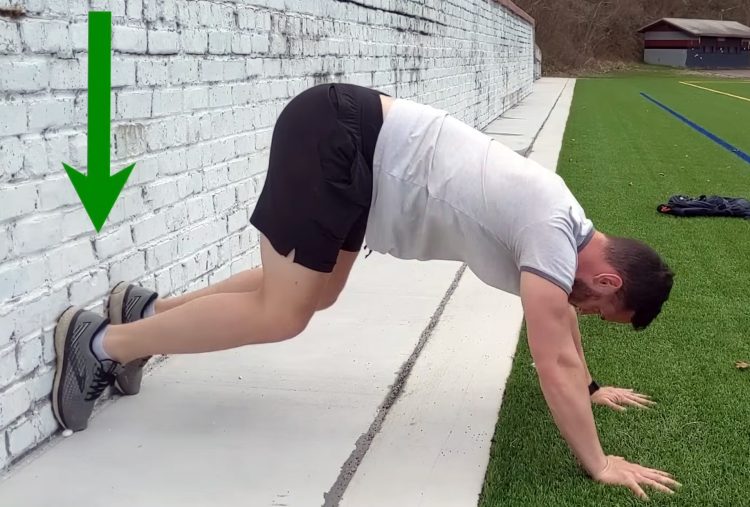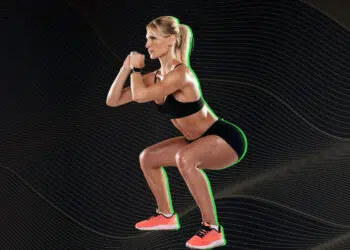Recently, I stumbled upon Mike Tyson push-ups and thought to myself — this might just be one of the best calisthenics exercises ever. So, I decided to give it a go.
My initial goal was to embark on a two-month challenge. If the exercise turned out to be great, I could implement it in my and my clients’ bodyweight training routines. However, it’s been only 30 days, and I am more than pleased.
So, instead of waiting another month, I decided to share my experience early. Today, I’ll tell you all about the exercise, how to do it, what to expect, and the results I achieved. I will also offer a few practical tips on making the most of Mike Tyson push-ups.
What Are Mike Tyson Push-Ups & Which Muscles Do They Work?

Mike Tyson push-ups are an advanced push-up variation that combines the basic elements of a traditional push-up with some lower-body movement. You could think of them as a mixture of a squat and a push-up.
This exercise provides a decent full-body workout, engaging multiple muscle groups simultaneously. The main goal of this exercise is to build strength and muscular endurance, but that’s far from the whole story. Performing only a few reps will make you question your mobility and coordination — especially if you’ve been heavily focused on hypertrophy training.
Mike Tyson push-ups target the following muscle groups:
Level Up Your Fitness: Join our 💪 strong community in Fitness Volt Newsletter. Get daily inspiration, expert-backed workouts, nutrition tips, the latest in strength sports, and the support you need to reach your goals. Subscribe for free!
- Triceps
- Chest
- Front delts
- Lower traps
- Core
- Rear delts
- Quads
- Glutes
My Experience With Mike Tyson Push-Ups
I must admit I underestimated the complexity and difficulty of this exercise even though I have spent more than a decade in the gym. Mike Tyson push-ups were hard to do even though I am in excellent shape, so don’t take them lightly.
My initial goal was to perform 75 push-ups in a row by the end of the second month, but after the first 20, I realized that I set the bar too high. My front delts, traps, and triceps were toast before I reached 30. So, during the first week, I just did three sets to failure, which usually got me to about 75–80 push-ups in total. My first-day personal best was 31 push-ups in a row.
After the first week, I was pretty comfortable with the movement. My heels were glued to the wall, my core and lower back were engaged at all times, and I was finally pushing up in one fluid motion (at first, I had to remind myself to push up and back, not up then back). Also, I was finally giving my lower traps a good workout, which, admittedly, was long overdue.
One thing I will say is that if you’re someone who trains legs often, Mike Tyson push-ups won’t do much for your quads or glutes. You will feel them burn a bit after you get enough reps in, but it will be nothing compared to what this exercise does to your upper body.
My Results
By the 30th day, I was certain I could perform 45 Mike Tyson push-ups, and sure enough, I did. I managed to do 50 Mike Tyson push-ups in a row on the final day of the challenge. Reaching my initial goal would likely take at least four to five months, maybe even more.
Apart from strength and endurance, my shoulder and back mobility improved quite a bit. My lower traps are one of my most underdeveloped muscles, and doing Mike Tyson push-ups helped strengthen them quite a bit, which helped with my shoulder mobility.
Due to years of playing tennis, my right shoulder is much more mobile than the left one. However, after only a month of performing Mike Tyson push-ups, I’ve noticed the gap getting smaller.
How To Perform Mike Tyson Push-Ups
Now that you know Mike Tyson push-ups bring excellent results, let me teach you how to do them:
Step One — Place Your Feet Against the Wall
Place your feet against the wall and touch the wall with your heels. Your toes should touch the ground.
Pro Tip: Do this in shoes so that you don’t hurt your toes, and keep your heel planted at all times. I wouldn’t recommend performing the exercise barefoot or in socks.
Step Two — Move Into the Push-Up Position
Move forward, and place your hands slightly wider than shoulder-width apart, with the palms in line with your shoulders.
Pro Tip: To make the exercise more delt and trap-heavy, move your palms 2–3 inches in front of your shoulders.
Step Three — Move Into a Squat
From the starting push-up position, bend your knees and push your hips back towards your heels, assuming the squat position. Your arms should be fully extended, and you should feel your lower traps and rear delts engaged.
Pro Tip: Keep your core and lower back engaged at all times. It is really easy to hinge forward and lose stability if you lose focus of your core and back for a brief moment.
Step Four — Drive Into the Push-Up
Driving forward through your heels (in a controlled manner), shift your body weight forward, controlling the movement with your shoulders. Stop when you get in a conventional push-up position. Lower your chest while keeping your elbows tucked and core engaged. Go as deep as possible.
Pro Tip: Don’t push through your lower body too hard or fast. Doing so will certainly affect your form.
Level Up Your Fitness: Join our 💪 strong community in Fitness Volt Newsletter. Get daily inspiration, expert-backed workouts, nutrition tips, the latest in strength sports, and the support you need to reach your goals. Subscribe for free!
Step Five — Push-Up (and Back)
Drive through your palms and push up. When your arms are about 60% extended, start pushing back simultaneously so you can return to the squat position. Repeat for recommended reps.
Pro Tip: Don’t push up and then back. This will limit both front and rear delt engagement and will put unnecessary stress on your rotator cuffs. Move up and back in one fluid motion.
Dr. Mike Israetel, a training and nutrition expert with a Ph.D. in Sport Physiology, explains why you should keep your buttocks elevated when doing push-ups:
“If you have your butt up significantly, it usually leverages you more forward, giving you a higher fractional load of your body to use for targeting your chest.”
What Can You Expect From Mike Tyson Push-Ups? (Benefits Explained)
I will certainly implement Mike Tyson push-ups in my and my clients’ calisthenics workouts moving forward as they can improve:
Strength
Despite the relatively complex movement, Mike Tyson push-ups are an excellent strength-building exercise, especially for the triceps and front delts. You will build explosive power in the triceps, chest, and front delts during the push-up portion of the exercise, but you will also hone your stability by training your rear delts, core, and lower traps.
Endurance
You will likely see the biggest progress in your muscular endurance and stamina. As you get accustomed to your own body weight, you will be able to perform more reps. More reps equal more endurance. (1) In time, the muscular endurance of your chest, triceps, delts, core, and even quads will rise substantially. Take it from me. I went from 31 push-ups to 50 push-ups in 30 days, so just imagine what could be accomplished in six months or a year.
Mobility
Mike Tyson push-ups require a good range of motion. In my case, I improved my shoulder mobility by fully stretching out my back and arms during the squat. However, you could also improve your hip, knee, and ankle mobility if you squat really deep while keeping your heels planted.
Coordination
Another aspect you’ll see improved is coordination and the fluidity of motion. As you get more accustomed to this compound exercise, you’ll become more secure and determined in your movement, resulting in one smooth motion from top to bottom (or squat to push-up).
Maintaining balance and form while transitioning between positions could easily translate into better performance in sports and everyday life, which is invaluable. It’s also one of the core principles of yoga, which we all know does wonders for coordination and mobility.
Cardio
Mike Tyson push-ups will get your heart rate up because you don’t get to stop or rest while performing it. You’re constantly moving, and since you’re not aiming for the eight to 12 rep range, your heart rate will stay elevated for quite a while, effectively improving your cardiovascular fitness and VO2 max.
It won’t improve your cardio like HIIT training, but as long as you keep your heart rate up (and you will), you will see benefits. (2)
Common Mistakes When Doing Mike Tyson Push-Ups and How To Avoid Them
Due to the dynamic and complex nature of the Mike Tyson push-ups, you can make an error every step of the way. The problem is that these errors can render the exercise useless and increase injury risk.
One common mistake (the one I also made early on) was inadequate core engagement, and the back to overarch. This puts a ton of stress on your spine. So, brace your core and maintain a straight line from your head to your hips.
Another standard error is losing heel-to-wall contact during the movement. This results in lesser quad engagement, but more importantly, it makes you a bit wobbly, which could, once again, lead to injury.
Finally, the third issue is rushing through the exercise and exploding from the squat. If you do this, you will destroy the form, lose balance, and absolutely wreck your shoulders. While you shouldn’t perform Mike Tyson push-ups slowly, maintaining control (especially once fatigue kicks in) is beyond vital.
FAQs
Did Mike Tyson create Mike Tyson push-ups?
From what I know, this exercise carries the boxer’s name because he was a big fan of calisthenic workouts, not because he invented this exercise. Some say Tyson used to do 500 push-ups daily in his prime, but those probably weren’t the “Mike Tyson” push-ups.
Are Mike Tyson push-ups beginner-friendly?
I wouldn’t call Mike Tyson push-ups beginner-friendly. I would recommend beginners stay away from these push-ups. The movement pattern is complex, and execution requires a great deal of coordination, strength, and balance. Unless performed perfectly, the costs will outweigh the benefits because there’s a great risk of injury. One wrong move and you’ll end up with a nasty knot in your back, which could sideline you from training for several days or weeks.
Do Mike Tyson push-ups build muscle?
Mike Tyson push-ups can help you build muscle, but they’re not the most hypertrophic exercise out there. If you’re looking to build muscle, I would suggest doing deficit push-ups to really stretch those chest fibers and drive hypertrophy. To make them even harder, you can perform them wearing a weighted vest.
Wrapping Up
All in all, the Mike Tyson push-ups have been extremely fun and equally challenging. They’ve helped me improve my strength, endurance, mobility, and coordination in just 30 days, and I’ve been training for a long time.
This shows you that sometimes, all it takes for a breakthrough is a little variety in your workouts. So, if you’re looking to experiment and freshen up your fitness routine, adding Mike Tyson push-ups is definitely a good idea. I am certainly going to keep them in mine.
Read also: Mike Tyson Workout and Diet Plan
References:
- Schoenfeld BJ, Grgic J, Van Every DW, Plotkin DL. Loading Recommendations for Muscle Strength, Hypertrophy, and Local Endurance: A Re-Examination of the Repetition Continuum. Sports (Basel). 2021 Feb 22;9(2):32. doi: 10.3390/sports9020032. PMID: 33671664; PMCID: PMC7927075.
- Ito S. High-intensity interval training for health benefits and care of cardiac diseases – The key to an efficient exercise protocol. World J Cardiol. 2019 Jul 26;11(7):171-188. doi: 10.4330/wjc.v11.i7.171. PMID: 31565193; PMCID: PMC6763680.








